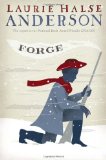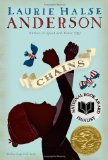
 Woods Runner
Woods Runner by Gary Paulsen
by Gary Paulsen
Samuel’s family lives in a small settlement in the woods. While his parents stick to the house and clearing, he dearly loves the forest. At 13 he can find his way easily through the dark trees and is responsible for most of the hunting for his family and neighbors. He has ventured farther than usual one day and when he turns to survey the land, he notices smoke emanating from the area of his home. He turns and runs the full 8 miles back to his family and finds the scene of a massacre.
A mixed group of British soldiers and Iroquois had raided the settlement. Paulsen’s graphic descriptions lay most of the responsibility for the deaths with the Iroquois – people are tomahawked and scalped, while there were few if any that were recounted as shot.
Paulsen’s Afterword seeks to clarify that he is trying to give a new perspective on the war, in particular the atrocities committed against civilians. He mentions that most accounts focus on the soldiers and glory and seeks to show the war in a new light. The Afterword throws around a lot of casualty numbers and tells of how the wounded rarely survived. What Paulsen does not bother to do is engage in any real discussion or provide any real information on the involvement of Native Americans in the American Revolution. It seems a bit irresponsible, no? He uses them in the beginning to show just how horrible raids against innocent people could be, but he never explains their stake in the war. There is one very brief mention that the British are paying for scalps, but that’s about it. A failure to explain any of the history of Iroquois involvement condemns them to the stereotypical role of savage. It’s a small detail, but I also couldn’t find evidence that they wore high moccasins. I’d like to assume Paulsen’s research was more detailed than mine, but as he made a conscious decision to demonize the Iroquois and not clarify their position in either the text of the book or the Afterword, I’m just not sure I trust him. Here’s a short article on Native Americans during the war, it’s not much but it is more than what is offered in Woods Runner.
The Native Americans weren’t the only ones who framed as causing atrocities during the war. The Hessians (hired German soldiers) also got a healthy portion of the blame. They are described as having “savage, atrocious behavior, and…they became know as little more than beasts.” Listed among their sins is the bayoneting of pregnant women and infants.
I have yet to read about a war where atrocities were not committed by both sides. Although I could find no evidence online of Hessians in particular bayoneting women and children, I am sure they are responsible for any number of horrible things that occurred during the war. My object to Paulsen’s book is that in his decision to frame the Iroquois and the Hessians as savages (and yes, he uses the term savage to describe both groups) he neglects to lay much blame with the British. The resulting impression is that the British were simply following the rules of war and not responsible for the same level of atrocities as those they recruited to assist in their efforts. It is most certainly untrue.
Sadly, the first half of the book which is filled with violence at the hands of these terrible people is also far more interesting than the second half. The action and tension and excitement and horror give way to a rather dull narrative. As Samuel takes Annie and tries to reunite with his family his journey becomes fairly safe and predictable, and the ending seems both unlikely and trite.
Due to the very descriptive nature of the violence, I would hesitatingly recommend this for Grades 5 and up, but I would be very careful with your fifth or sixth grader and make sure they can handle the level of gore. The worst of the descriptions take place before page 40 I believe, so thumb through it first.
Good For: It can be difficult to teach critical thinking and text analysis. Students are often so focused on understanding what is happening that they don’t get a chance to sit back and wonder at the author’s bias or agenda. They’ve also often been heavily trained that books contain information that they should learn. If I were to use this in a teaching scenario, I would combine it with research and analysis so that students could make judgments about whether or not Paulsen was providing an unbiased picture of the war and whether or not the material they were supposed to “learn” was accurate.
Sex, Nudity, Dating – Samuel’s pants are removed so he doesn’t soil himself when he is unconscious. They claim that George III of England removes his clothes sometimes when he is crazy.
Profanity – “hell,” “damn,”
Death, Violence and Gore – Samuel is a hunter and kills various animals. He has seen the bodies of men who die in the woods from confusion, Indians or animal attack, including a man who’s head was eaten off by a bear and a man with an arrow through the throat. Weapons used and describe include bayonets, grape shot, cannons, tomahawks, muskets, rifles. Samuel can smell blood and death. Grapeshot rips men apart. People are filled with arrows. A man’s scalp is gone and what remains of his face hangs in a droopy manner. Bodies are mutilated past the point of recognition. The dead include young children. Samuel must bury bodies so they are not eaten by scavenging animals. Wounded are left to die. There are more scalpings and fresh scalps. Samuel kills a few people. A tomahawk splits his scalp. Gangrene, amputation and the use of maggots to eat rotting flesh are described. A man is shot in the stomach and survives for four days in agony before dying. Hessians are accused of bayoneting children, women, pregnant women and infants. Two people are shot in cold blood. Soldiers attempt to shoot a child but fail. A man fears hanging. 10,000 prisoners died of intentional neglect. Horses are killed. People are starving to death.
Drugs, Alcohol and Smoking – Tobacco is used by many in the form of chewing tobacco, dipping stuff and smoking pipes. A man drinks milk mixed with rum. There are drunks. A man dispenses laudanum to the wounded.
Frightening or Intense Things – The first part of the book is filled with gore, but also with tension as you fear for the lives of the characters. We learn that most children orphaned during the revolution were raised in institutions, not adopted. The terrible conditions in prisons are described to an extent.
by Patricia Polacco (sometimes I used Thunder Cake
, it depended on how many copies I could find!) This book is a DRA 24, Guided Reading Level M.
by Tomie dePaola. This book is a DRA 30, Guided Reading Level N.
This book is a DRA 40, Guided Reading Level Q.










